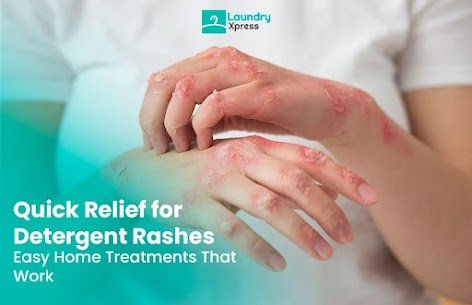People usually experience detergent rashes, as the skin is exposed to dangerous chemicals contained in the laundry. These rashes usually lead to redness, itching, swelling, and general discomfort. It is important to start the treatment immediately so that the symptoms can relieve and the occurrence of problems can be avoided. Luckily, a few home remedies are very helpful and can give quick and long-lasting relief to the people with mild to moderate cases.
Understanding Detergent Rashes
What Are Detergent Rashes?
Detergent rashes are a form of contact dermatitis triggered by exposure to irritants or allergens found in laundry products. These rashes often appear where clothing fits tightly, such as the armpits, waistband, or neck.
Common Symptoms and Skin Reactions
Symptoms may include:
- Red, inflamed skin
- Itching or burning sensations
- Blisters or dry patches
- Peeling or flaking
First Steps to Take When a Rash Appears
Discontinue Use of Suspected Detergent
Quit using the product you suspect to be the cause right away. By doing so, you prevent the rash from getting worse, and it is the first stage of the healing process. If the laundry detergent has a particularly bad odor, it is better to go with a product that is natural and has a mild fragrance.
Rinse Affected Skin Gently
When you are rinsing the skin, you should use cold water and soap that is gentle and free of fragrance. In order to avoid inflammation, it is recommended that you stay off the hot water.
Switch to Hypoallergenic Options
The best way to take care of your skin is to go for a hypoallergenic laundry detergent that is fragrance-free and made of a plant-based composition. This kind of detergent is gentle on your skin and will not cause the irritation that others might produce.
Best Immediate Relief Options
Cool Compress Application
Take a damp, cool cloth and place it on the area of skin with the rash. Leave it for 15 minutes. This will make you less itchy and the swelling will go down faster.
Oatmeal Bath Soaks
Oatmeal paste has the characteristic of being anti-inflammation. Similarly, besides its anti-oxidative properties, the fiber content is again effective for skin rejuvenation. Thus, warm baths including oatmeal might effectively alleviate skin discomfort and enhance the regeneration of the epidermis.
Aloe Vera Gel Use
Pure aloe vera gel soothes redness and provides a cooling effect. Use gel directly from the plant or buy fragrance-free, 100% aloe vera gel.
Natural Home Remedies that Work
Moisturizing with Coconut Oil
Coconut oil is a natural moisturizing agent that can not only provide immediate relief but also accelerate your recovery process. Use a bit of the product on your clean and dry skin to let the natural process heal.
Vinegar Water Solution
First of all, dilute apple cider vinegar with an equal amount of water, then gently apply the solution to your skin using a cotton ball. The skin pH is neutralized, and the growth of bacteria is inhibited by this product.
Baking Soda and Water
Create a paste by mixing baking soda and water together. Dab the paste on the affected area, and you will feel the acids neutralized and the itching will be gone.
What Not to Do When You Have a Detergent Rash
Avoid Scratching
Scratching worsens the rash and increases the risk of infection. Keep nails trimmed and wear soft clothing.
Don’t Apply Random Creams
Avoid unverified treatments that may contain irritating ingredients. Always read product labels.
No Harsh Scrubbing or Hot Water
Hot water and abrasive cloths strip protective oils and aggravate the rash further.
Detergent rashes can be distressing, but with the right home remedies and preventive measures, they are usually easy to treat and avoid. Identify the irritant, soothe your skin with natural solutions, and switch to safer laundry practices. By acting quickly and using the right treatments, you can protect your skin and prevent future flare-ups.
For lasting peace of mind, consider professional laundry solutions like Laundry Xpress, which uses skin-safe, hypoallergenic products and careful washing methods to help prevent detergent-related skin issues before they start.
FAQs
1- How long does a detergent rash last?
Most rashes resolve within a few days to a week if the irritant is removed and proper care is taken.
2- Can natural detergents still cause rashes?
Yes. Even plant-based or “natural” detergents can contain allergens or irritating ingredients for some people.
3- Should I rewash my clothes if I get a rash?
Yes. Rewash all garments using a gentle, fragrance-free detergent and an extra rinse cycle to remove any residual irritants.
4- Is it safe to use steroid creams?
Mild over-the-counter steroid creams like 1% hydrocortisone are generally safe for short-term use. Avoid long-term use without medical supervision.
5- Are detergent rashes contagious?
No. Detergent rashes are not contagious and cannot be spread through contact.





